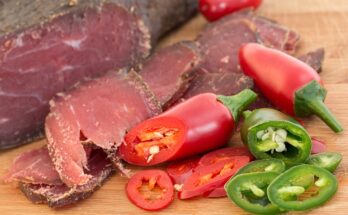Are you curious about how food processing affects the texture of your favorite meals?
Well, look no further! In this article, we will explore the fascinating world of food texture and how various processing techniques can alter it.
From mechanical methods that involve grinding and cutting to thermal techniques like cooking and baking, you’ll discover how these processes can transform the texture of your food.
We will also delve into the effects of chemical processing, such as adding preservatives and flavor enhancers, and how they can impact the texture of our meals.
Additionally, we will explore enzymatic processes and their role in creating unique textures in certain foods.
Lastly, we will touch on the effects of packaging and storage on food texture.
So, get ready to dive into the science of food processing and uncover the secrets behind the textures we love.
Mechanical Processing Methods
Mechanical processing methods greatly alter the texture of food. When you use mechanical processing methods, such as chopping, grinding, or blending, you break down the structure of the food, resulting in a smoother and more uniform texture.
For example, when you chop vegetables, the cell walls are disrupted, releasing their contents and causing the vegetables to become softer. Similarly, when you grind coffee beans, the beans are broken into smaller particles, resulting in a finer texture and more intense flavor.
Mechanical processing methods also play a crucial role in the production of processed foods, such as canned soups or purees. Through techniques like milling or extrusion, the texture of these foods can be modified to achieve the desired consistency.
So, next time you chop, grind, or blend your food, remember that you are not only changing its shape but also its texture.
Thermal Processing Techniques
Thermal techniques, like cooking and baking, transform the texture of our favorite dishes, making them more enjoyable and tantalizing to our taste buds.
These techniques involve the application of heat to food, which alters its properties in various ways. For example, cooking meat at high temperatures causes proteins to denature and collagen to break down, resulting in a tender and juicy texture.
Baking bread involves the process of kneading and proofing the dough, followed by baking it in an oven. This combination of mechanical and thermal processing creates a light and airy texture with a crispy crust.
Additionally, thermal processing techniques such as blanching and pasteurization help preserve the texture of fruits and vegetables, ensuring they stay firm and retain their natural flavors.
Overall, thermal processing plays a crucial role in enhancing the texture of our food, making it more enjoyable and satisfying.
Chemical Processing Effects
To truly appreciate the amazing flavors of your favorite dishes, you need to understand how chemical processing techniques can profoundly alter the taste and quality.
Chemical processing plays a crucial role in food production. It can enhance or modify the texture of various food products. One common chemical processing technique is called acidification. It involves the addition of acids such as vinegar or lemon juice to alter the pH of the food. This can result in a tangy or sour taste, as well as a firmer texture in certain foods like pickles.
Another technique is enzymatic processing. Enzymes are added to break down proteins or carbohydrates, leading to changes in texture. For example, enzymes can be used to tenderize meat or to create a smooth and creamy texture in dairy products.
Chemical processing techniques allow for a wide range of textures and flavors, making your favorite dishes even more enjoyable.
Enzymatic Processes and Texture
Enhance your culinary experience by understanding how enzymatic processes can transform the texture of your favorite dishes, leaving you craving for more.

Enzymes play a crucial role in food processing, breaking down complex molecules to create unique textures. One example is the enzymatic conversion of starch into sugars during the ripening of fruits. This process softens the fruit and gives it a desirable, melt-in-your-mouth texture.
Enzymes like pectinase are used to break down pectin, a substance that gives fruits and vegetables their firmness. By controlling the activity of these enzymes, food processors can achieve the perfect texture in products like jams, jellies, and sauces.
Enzymatic processes also contribute to the formation of flavors, making your favorite dishes even more delicious. So next time you enjoy a perfectly tender and flavorful dish, remember the impact of enzymatic processes on its texture.
Effects of Packaging and Storage
Packaging and storage conditions can greatly influence the quality and shelf life of culinary products. When it comes to food texture, the effects of packaging and storage cannot be overlooked.
The choice of packaging material can determine how much moisture is retained, which in turn affects the texture of the food. For example, if a food product is packaged in a material that allows moisture to escape, it can become dry and lose its desired texture. On the other hand, if the packaging material is too moisture-resistant, the food may become soggy and have an undesirable texture.
Proper storage conditions, such as temperature and humidity, also play a crucial role in maintaining the desired texture of culinary products. If stored in unsuitable conditions, the texture can deteriorate, resulting in a less enjoyable eating experience.
Therefore, it is essential to carefully consider packaging and storage methods to preserve the desired texture of culinary products.
Conclusion
In conclusion, food processing has a significant impact on food texture. Mechanical processing methods, such as grinding or milling, can affect the size and shape of food particles, resulting in changes in texture.
Thermal processing techniques, such as cooking or pasteurization, can alter the structure of proteins and carbohydrates, leading to changes in texture.
Chemical processing effects, such as the addition of preservatives or stabilizers, can also impact texture.
Enzymatic processes and the effects of packaging and storage further contribute to the overall texture of processed food.




